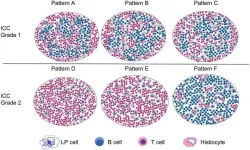(Press-News.org) Research Highlights:
Adults in white-collar jobs in Canada with high job strain and for whom significant efforts are met with low rewards (such as low salary or recognition) may face a 97% increased risk for developing the irregular heart rhythm condition known as atrial fibrillation, or AFib or AF, compared to workers not exposed to these work stressors.
Separately, high job strain alone was associated with an 83% higher risk of developing AFib, and effort-reward imbalance alone was associated with a 44% greater risk.
Recognizing and addressing these stressors at work may be an effective strategy to prevent atrial fibrillation in adults, researchers said.
Embargoed until 4 a.m. CT/5 a.m. ET Wednesday, Aug. 14, 2024
DALLAS, Aug. 14, 2024 — Work-related stress caused by job strain and an imbalance between efforts applied vs. rewards received may increase the risk of developing atrial fibrillation, according to new research published today in the Journal of the American Heart Association, an open access, peer-reviewed journal of the American Heart Association.
Also known as AFib or AF, atrial fibrillation is the most common form of arrhythmia – an abnormal heart rhythm. It can lead to stroke, heart failure or other cardiovascular complications. More than 12 million people are projected to have AFib in the United States by 2030, according to the American Heart Association’s 2024 heart disease and stroke statistics.
Previous research linked high job strain and effort-reward imbalance at work with an increased risk of coronary heart disease. This research is the first to examine the adverse effect of both psychosocial stressors at work on atrial fibrillation, said the study’s senior author Xavier Trudel, Ph.D., an occupational and cardiovascular epidemiologist and associate professor at Laval University in Quebec City, Quebec, Canada.
“Our study suggests that work-related stressors may be relevant factors to include in preventive strategies,” Trudel said. “Recognizing and addressing psychosocial stressors at work are required to foster healthy work environments that benefit both individuals and the organizations where they work.”
Trudel and team studied the impact of job strain, which refers to a work environment in which employees face high job demands, such as a heavy workload and tight deadlines, and low control over their work with little say in decision-making and how they execute their tasks.
Another factor assessed in the study was the effort-reward imbalance. This occurs when employees invest significant effort into their work but perceive the rewards they get in return — such as salary, recognition or job security — as insufficient or unequal to their performance.
Researchers examined medical database records for nearly 6,000 adults in white-collar jobs in Canada, with 18 years of follow-up data. The analysis found that:
employees who said they experienced high job strain had an 83% higher risk of developing AFib compared to workers unaffected by the stressors;
those who perceived an effort-reward imbalance had a 44% greater risk, compared to workers who did not report this imbalance; and
combined perceptions of high job strain and effort-reward imbalance were associated with a 97% increased risk of AFib.
“The effectiveness of workplace interventions to reduce psychosocial stressors that may also reduce the risk of AFib should be investigated in future research efforts,” Trudel said. “Our research team previously conducted an organizational intervention designed to reduce psychosocial stressors at work, which was shown to effectively reduce blood pressure levels. Examples of organizational changes implemented during the intervention included slowing down the implementation of a large project to prevent increased workload; implementing flexible work hours; and holding meetings between managers and employees to discuss day-to-day challenges.”
Limitations of the study include that participants were all white-collar workers encompassing managers, professional and office workers in Canada which means results may not apply to other types of workers or to workers in other countries.
Study details, background or design:
Researchers collected data through the PROspective Quebec (PROQ) Study on Work and Health, which started in the Quebec region in 1991-1993 and recruited white-collar workers from 19 public and semi-public organizations.
A total of 5,926 workers (49% men, 51% women) were included in this analysis. Their average age was 45 at the beginning of the study (1999-2001) and 65 at the end of the follow-up (Dec. 2018). Most study participants were white adults.
Work stress was assessed from self-reported questionnaires.
The analysis identified 186 AFib cases, and among that group, 19% of the people with AFib reported high job strain; 25% said they perceived effort-reward imbalance; and 10% reported experiencing both stressors simultaneously.
More than one-third of participants had been diagnosed with coronary heart disease or heart failure before their AFib incidence.
The study measured the work-related stressors through self-reported questionnaires specifically on job strain and effort-reward imbalance, controlling for a broad list of socioeconomic characteristics (sex and education), health risks (diabetes status and high blood pressure) and lifestyle factors (smoking and alcohol).
Co-authors, disclosures and funding sources are listed in the manuscript.
Studies published in the American Heart Association’s scientific journals are peer-reviewed. The statements and conclusions in each manuscript are solely those of the study authors and do not necessarily reflect the Association’s policy or position. The Association makes no representation or guarantee as to their accuracy or reliability. The Association receives funding primarily from individuals; foundations and corporations (including pharmaceutical, device manufacturers and other companies) also make donations and fund specific Association programs and events. The Association has strict policies to prevent these relationships from influencing the science content. Revenues from pharmaceutical and biotech companies, device manufacturers and health insurance providers and the Association’s overall financial information are available here.
Additional Resources:
Multimedia is available on the right column of release link http://newsroom.heart.org/news/work-related-stress-may-increase-the-risk-of-an-irregular-heart-rhythm?preview=fda43df8a3977e18e323b52c3e660d44
After Aug. 14, view the manuscript online.
AHA news release: Job strain combined with high efforts and low reward doubled men’s heart disease risk (Sept. 2023)
AHA news release: Work-related stress linked to increased risk for peripheral artery disease (April 2020)
AHA health information: Stress and Heart Health
AHA initiative: Well-being Works Better™
Follow AHA/ASA news on X @HeartNews
Follow news from the Journal of the American Heart Association @JAHA_AHA
###
About the American Heart Association
The American Heart Association is a relentless force for a world of longer, healthier lives. We are dedicated to ensuring equitable health in all communities. Through collaboration with numerous organizations, and powered by millions of volunteers, we fund innovative research, advocate for the public’s health and share lifesaving resources. The Dallas-based organization has been a leading source of health information for a century. During 2024 - our Centennial year - we celebrate our rich 100-year history and accomplishments. As we forge ahead into our second century of bold discovery and impact, our vision is to advance health and hope for everyone, everywhere. Connect with us on heart.org, Facebook, X or by calling 1-800-AHA-USA1.
END
Work-related stress may increase the risk of an irregular heart rhythm
Job strain and effort-reward imbalance at work were associated with a greater chance of developing an abnormal heart rhythm condition, finds new study in the Journal of the American Heart Association
2024-08-14
ELSE PRESS RELEASES FROM THIS DATE:
Massive biomolecular shifts occur in our 40s and 60s, Stanford Medicine researchers find
2024-08-14
If it’s ever felt like everything in your body is breaking down at once, that might not be your imagination. A new Stanford Medicine study shows that many of our molecules and microorganisms dramatically rise or fall in number during our 40s and 60s.
Researchers assessed many thousands of different molecules in people from age 25 to 75, as well as their microbiomes — the bacteria, viruses and fungi that live inside us and on our skin — and found that the abundance of most molecules ...
Study reveals that memories of the COVID-19 pandemic lockdowns predict declines in psychological well-being of children and adolescents
2024-08-14
The COVID-19 pandemic and the lockdown measures to prevent contagion resulted in extensive disruptions in children’s and adolescents’ everyday lives. A new study in Child Development from the Aarhus University Hospital in Denmark, University of California, Riverside and University of California, Davis in the United States, investigated personal memories (i.e., memories for episodes experienced in one’s own life) about the first lockdown in Denmark in Spring 2020 among children and adolescents and how this may have impacted their psychological well-being over the following year.
For context, in ...
Severe menopause symptoms may take toll on brain health
2024-08-14
CLEVELAND, Ohio (August 14, 2024)—With more than 24 million people globally living with dementia without a cure in sight, there is a lot of focus on ways to prevent and delay cognitive impairment. A new study suggests that severe menopause symptoms such as hot flashes and depression can negatively affect cognitive function in postmenopausal women. Results of the study are published online today in Menopause, the journal of The Menopause Society.
In conjunction with our aging population, dementia diagnoses are on the rise. It ...
Historic map reveals how mussel farm is bringing shellfish reefs back to the seabed
2024-08-14
The UK’s first large scale offshore mussel farm is allowing shellfish reefs to return to parts of the seabed off England’s south coast for the first time in up to 150 years, a new study has revealed.
Researchers have spent the past decade examining the environmental impact of the farm, which was first established in Lyme Bay off the coast of South Devon in 2013.
In that time, the seabed beneath the farm’s ropes has begun to undergo a transformation as mussels from the lines are ...
Power up your health with self-sustaining electronics
2024-08-14
Imagine a coat that captures solar energy to keep you cozy on a chilly winter walk, or a shirt that can monitor your heart rate and temperature. Picture clothing athletes can wear to track their performance without the need for bulky battery packs.
University of Waterloo researchers have developed a smart fabric with these remarkable capabilities. The fabric has the potential for energy harvesting, health monitoring, and movement tracking applications.
The new fabric developed ...
Histopathologic features and differential diagnosis in challenging cases of nodular lymphocyte predominant B-cell lymphoma/Nodular Lymphocyte Predominant Hodgkin Lymphoma
2024-08-14
This review offers an in-depth exploration of Nodular Lymphocyte Predominant Hodgkin Lymphoma (NLPHL), highlighting its distinct characteristics across various domains such as epidemiology, clinical presentation, histopathology, immunophenotype, genetic findings, and challenges in differential diagnosis.
Epidemiology and Clinical Presentation
NLPHL is a relatively rare subtype of Hodgkin lymphoma, comprising approximately 10% of all Hodgkin lymphoma cases. It predominantly affects males, with a higher incidence observed ...
Trojan horse method gives malaria parasites a taste of their own medicine
2024-08-14
More than a quarter of Australians over the age of 50 take cholesterol-lowering drugs to prevent heart disease and strokes, but our bodies also need cholesterol to survive. Now, scientists from The Australian National University (ANU) say its role as a basic building block of life holds the key to treating deadly diseases caused by parasites, including malaria.
The researchers have developed a trojan horse method that tricks malaria parasites into ingesting a fatal dose of drugs by exploiting the parasite’s need for cholesterol to survive. By attaching ...
Singapore scientists discover breakthrough method to activate dormant stem cells in the brain
2024-08-14
Scientists from Duke-NUS Medical School and the Mechanobiology Institute (MBI) at the National University of Singapore (NUS) have discovered a novel pathway to wake up dormant neural stem cells, offering potential new therapies for neurodevelopmental disorders such as autism, learning disabilities, and cerebral palsy.
In the mammalian adult brain, most neural stem cells, which originate from the nervous system and can grow into various types of brain cells, stay dormant until they receive specific signals that activate them. Once woken up, they produce new neurons, aiding in brain repair and growth.
Defects in neural stem cell activation ...
Rare archaeological site reveals ‘surprising’ Neanderthal behaviour at Pyrenees foothills
2024-08-14
An unchartered area in the foothills of the Southern Pyrenees in Spain is providing insights into a poorly known period of Neanderthal history, offering clues that could help archaeologists uncover the mystery of their downfall, according to new research from The Australian National University (ANU).
Abric Pizarro is one of only a few sites worldwide dating from 100,000 to 65,000 years ago during a period called MIS 4. The researchers have gathered hundreds of thousands of artefacts, including stone tools, animal bones and other evidence, providing significant data about the Neanderthal way of life during that time -- largely unknown in human history until now.
The findings ...
How our biases are reflected in how fast we make decisions
2024-08-14
Quick decisions are more likely influenced by initial biases, resulting in faulty conclusions, while decisions that take time are more likely the result in better information, according to new research led by applied mathematicians at the University of Utah.
A team that included Sean Lawley, an associate professor of mathematics, and three former or current Utah graduate students used the power of numbers to test a decision-making model long used in psychology.
They developed a framework to study the decision-making processes in groups of people holding various levels of bias.
“In large populations, what we see is that slow deciders are making more accurate ...
LAST 30 PRESS RELEASES:
Exposure to natural light improves metabolic health
As we age, immune cells protect the spinal cord
New expert guidance urges caution before surgery for patients with treatment-resistant constipation
Solar hydrogen can now be produced efficiently without the scarce metal platinum
Sleeping in on weekends may help boost teens’ mental health
Study: Teens use cellphones for an hour a day at school
After more than two years of war, Palestinian children are hungry, denied education and “like the living dead”
The untold story of life with Prader-Willi syndrome - according to the siblings who live it
How the parasite that ‘gave up sex’ found more hosts – and why its victory won’t last
When is it time to jump? The boiling frog problem of AI use in physics education
Twitter data reveals partisan divide in understanding why pollen season's getting worse
AI is quick but risky for updating old software
Revolutionizing biosecurity: new multi-omics framework to transform invasive species management
From ancient herb to modern medicine: new review unveils the multi-targeted healing potential of Borago officinalis
Building a global scientific community: Biological Diversity Journal announces dual recruitment of Editorial Board and Youth Editorial Board members
Microbes that break down antibiotics help protect ecosystems under drug pollution
Smart biochar that remembers pollutants offers a new way to clean water and recycle biomass
Rice genes matter more than domestication in shaping plant microbiomes
Ticking time bomb: Some farmers report as many as 70 tick encounters over a 6-month period
Turning garden and crop waste into plastics
Scientists discover ‘platypus galaxies’ in the early universe
Seeing thyroid cancer in a new light: when AI meets label-free imaging in the operating room
Neutrophil-to-lymphocyte ratio may aid risk stratification in depressive disorder
2026 Seismological Society of America Annual Meeting
AI-powered ECG analysis offers promising path for early detection of chronic obstructive pulmonary disease, says Mount Sinai researchers
GIMM uncovers flaws in lab-grown heart cells and paves the way for improved treatments
Cracking the evolutionary code of sleep
Medications could help the aging brain cope with surgery, memory impairment
Back pain linked to worse sleep years later in men over 65, according to study
CDC urges ‘shared decision-making’ on some childhood vaccines; many unclear about what that means
[Press-News.org] Work-related stress may increase the risk of an irregular heart rhythmJob strain and effort-reward imbalance at work were associated with a greater chance of developing an abnormal heart rhythm condition, finds new study in the Journal of the American Heart Association





